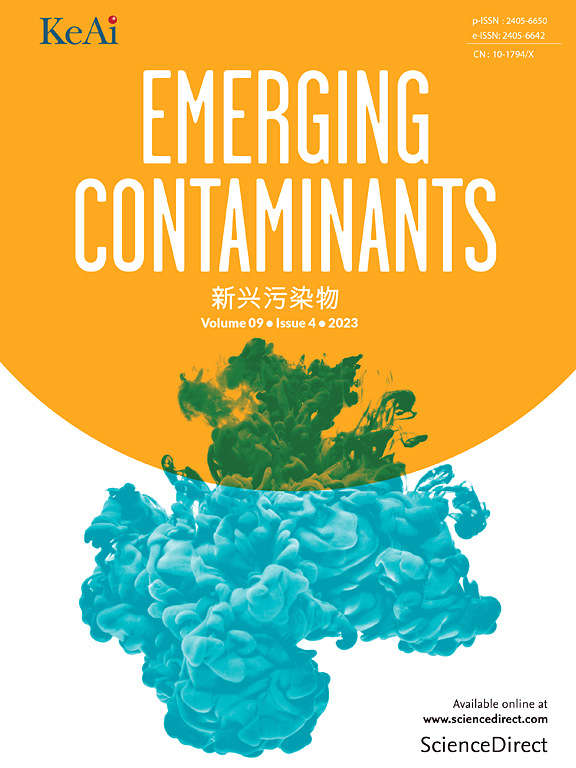Study on factors influencing the transport and transformation of polycyclic aromatic hydrocarbons in soil–groundwater systems
IF 6.9
2区 环境科学与生态学
Q1 ENVIRONMENTAL SCIENCES
引用次数: 0
Abstract
In this review, the migration and transformation behavior of polycyclic aromatic hydrocarbons (PAHs) in the soil–groundwater system and their interaction with environmental factors are discussed. The migration and transformation of PAHs are mainly regulated by organic matter, soil depth, surface water, and microbial community. Soil organic matter fixes PAHs through adsorption sites and active functional groups (including carbonyl and carboxyl groups), while microbial communities mineralize PAHs into H2O, CO2 (aerobic), and CH4 (anaerobic) through metabolic pathways, such as oxygenase, dehydrogenase, and lignin decomposer. However, these mechanisms are influenced by pH, temperature, oxygen, microbial population, and PAH structure. In addition, the migration and transformation of PAHs in soil–groundwater systems significantly differ in response to soil depth (e.g., shallow soil versus deep soil) and surface water. The behavior of PAHs in a single environmental medium has been explored. However, studies on the migration and transformation of PAHs from the perspective of the soil–groundwater system are rarely reported, and only limited studies on soil depth and the interaction between surface water and groundwater have been reported. Therefore, this review is the first to comprehensively analyze the migration and transformation behavior of PAHs from the perspective of the whole soil–groundwater system, incorporating multiple factors (such as surface water, soil depth, soil organic matter, pH, and microorganisms) in the system, filling the gaps in existing studies. This study aims to provide a theoretical framework for future research on the environmental behavior effects of PAHs at the soil–groundwater interface and the contribution of environmental factors to PAH pollution.
土壤-地下水系统中多环芳烃运移转化影响因素研究
本文综述了多环芳烃(PAHs)在土壤-地下水系统中的迁移转化行为及其与环境因子的相互作用。多环芳烃的迁移转化主要受有机质、土壤深度、地表水和微生物群落的调控。土壤有机质通过吸附位点和活性官能团(包括羰基和羧基)固定多环芳烃,微生物群落通过加氧酶、脱氢酶、木质素分解者等代谢途径将多环芳烃矿化为H2O、CO2(好氧)和CH4(厌氧)。然而,这些机制受到pH值、温度、氧气、微生物种群和多环芳烃结构的影响。此外,土壤-地下水系统中多环芳烃的迁移和转化对土壤深度(如浅层土壤与深层土壤)和地表水的响应存在显著差异。研究了多环芳烃在单一环境介质中的行为。然而,从土壤-地下水系统角度研究多环芳烃迁移转化的报道较少,对土壤深度和地表水与地下水相互作用的研究也比较有限。因此,本文首次从整个土壤-地下水系统的角度,将地表水、土壤深度、土壤有机质、pH、微生物等多因素纳入系统,全面分析多环芳烃的迁移转化行为,填补了现有研究的空白。本研究旨在为今后研究多环芳烃在土壤-地下水界面的环境行为效应以及环境因子对多环芳烃污染的贡献提供理论框架。
本文章由计算机程序翻译,如有差异,请以英文原文为准。
求助全文
约1分钟内获得全文
求助全文
来源期刊

Emerging Contaminants
Medicine-Public Health, Environmental and Occupational Health
CiteScore
10.00
自引率
6.70%
发文量
35
审稿时长
44 days
期刊介绍:
Emerging Contaminants is an outlet for world-leading research addressing problems associated with environmental contamination caused by emerging contaminants and their solutions. Emerging contaminants are defined as chemicals that are not currently (or have been only recently) regulated and about which there exist concerns regarding their impact on human or ecological health. Examples of emerging contaminants include disinfection by-products, pharmaceutical and personal care products, persistent organic chemicals, and mercury etc. as well as their degradation products. We encourage papers addressing science that facilitates greater understanding of the nature, extent, and impacts of the presence of emerging contaminants in the environment; technology that exploits original principles to reduce and control their environmental presence; as well as the development, implementation and efficacy of national and international policies to protect human health and the environment from emerging contaminants.
 求助内容:
求助内容: 应助结果提醒方式:
应助结果提醒方式:


